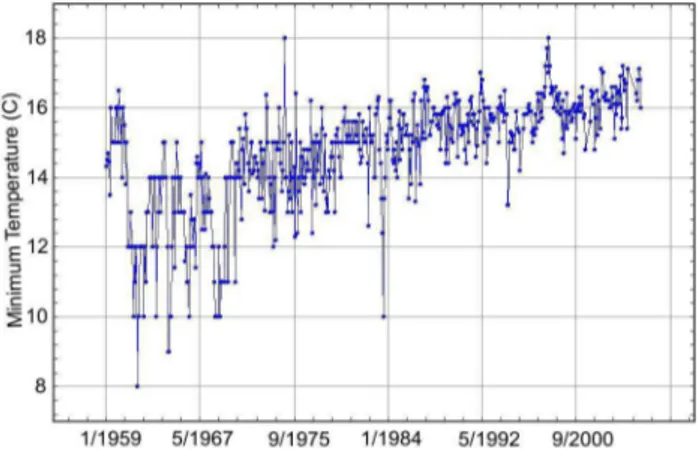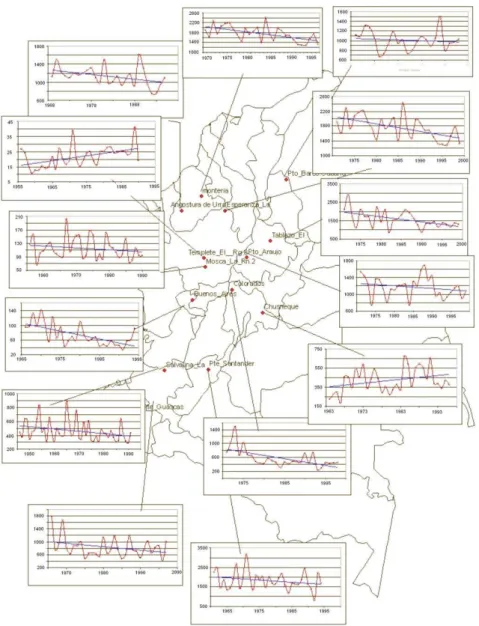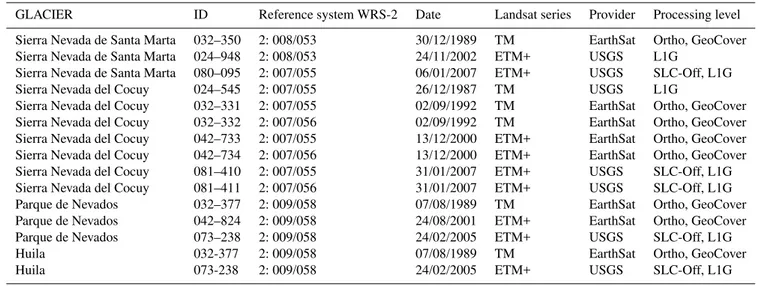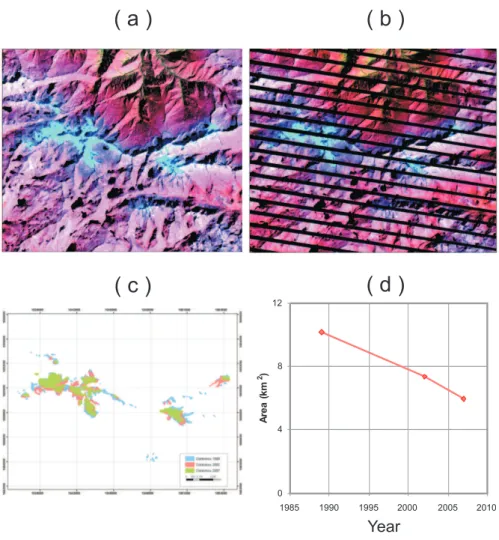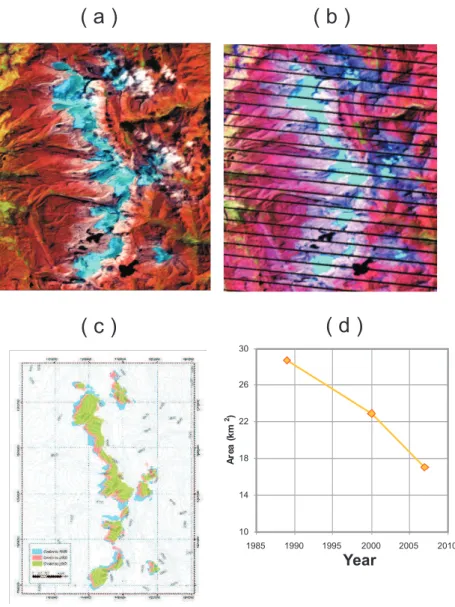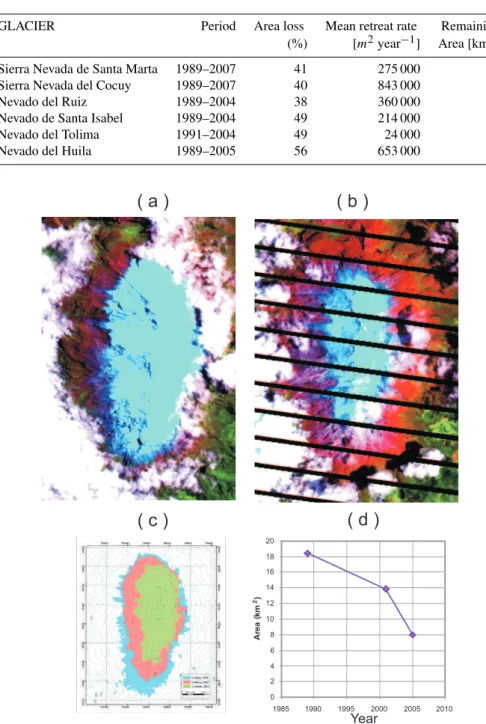www.adv-geosci.net/22/107/2009/
© Author(s) 2009. This work is distributed under the Creative Commons Attribution 3.0 License.
Geosciences
Reassessment of Colombia’s tropical glaciers retreat rates: are they
bound to disappear during the 2010–2020 decade?
G. Poveda and K. Pineda
Graduate Programme in Water Resources, School of Geosciences and Environment, Universidad Nacional de Colombia, Medell´ın, Colombia
Received: 19 May 2009 – Revised: 13 June 2009 – Accepted: 1 July 2009 – Published: 14 December 2009
Abstract. Clear-cut evidences of global environmental change in Colombia are discussed for diverse hydro-climatic records, and illustrated herein for increasing minimum temperature and decreasing annual maximum river flows records. As a consequence, eight tropical glaciers disap-peared from the Colombian Andes during the 20th century, and the remaining six have experienced alarming retreat rates during the last decade. Here we report an updated estima-tion of retreat rates in the six remaining glacierized moun-tain ranges of Colombia for the period 1987–2007, using Landsat TM and TM+ imagery. Analyses are performed us-ing detailed pre-processus-ing, processus-ing and post-processus-ing satellite imagery techniques. Alarming retreat rates are con-firmed in the studied glaciers, with an overall area shrink-age from 60 km2in 2002, to 55.4 km2in 2003, to less than 45 km2in 2007. Assuming such linear loss rate (∼3 km2per year), for the near and medium term, the total collapse of the Colombian glaciers can be foreseen by 2022, but diverse physical mechanisms discussed herein would exacerbate the shrinkage processes, thus prompting us to forecast a much earlier deadline by the late 2010–2020 decade, long before the 100 years foreseen by the 2007 IPCC Fourth Assessment Report. This forecast demands detailed monitoring studies of mass and energy balances. Our updated estimations of Colombia’s glacier retreat rates posse serious challenges for highly valuable ecosystem services, including water supply of several large cities and hundreds of rural settlements along the Colombian Andes, but also for cheap and renewable hy-dropower generation which provides 80% of Colombia’s de-mand. Also, the identified changes threaten the survivabil-ity of unique and fragile ecosystems likeparamosand cloud forests, in turn contributing to exacerbate social unrest and
Correspondence to:G. Poveda (gpoveda@unal.edu.co)
ongoing environmental problems in the tropical Andes which have been identified as the most criticalhotspotfor biodiver-sity on Earth. Colombia requires support from the global adaptation fund to develop research, and to design policies, strategies and tools to cope with these urgent social and en-vironmental threats.
1 Introduction
108 G. Poveda and K. Pineda: Colombia’s tropical glaciers retreat
Sierra Nevada de Santa Marta
Nevado del Ruiz, Nevado Santa Isabel and Nevado del Tolima
Nevado del Huila
Caribbean Sea
PacificOcean
Sierra Nevada del Cocuy
Fig. 1.Location of the six Colombian glacierized mountain ranges studied herein. The figure was made up using 12 June 2009 Google Earth imagery.
can be explained by the combined effects of deforestation, land use/land change, with global environmental change. It is impossible to disentangle the particular effect of either pro-cesses. Table 1 summarizes the number of hydro-climatic times series which were identified to exhibit positive, nega-tive or no trends in the aforementioned studies.
1.2 Colombian glaciers’ retreat
Tropical glaciers are unique and singular environments on Earth. The usually small size of inner tropical glaciers makes them highly sensitive to short timescales climate variabil-ity (Ceballos et al., 2006; Ramirez et al., 2001; Francou et al., 2003; Vuille et al., 2008), thereby constituting excellent proxies of regional and global climate change (Hastenrath and Kruss, 1992). The chapter on Latin America included in the 2007 Fourth Assessment Report of the Intergovernmental Panel on Climate Change (IPCC AR4) (Magrin et al., 2007), reported alarming and intensifying glacier retreat trends in the tropical Andes, reaching critical conditions in Bolivia, Peru, Colombia and Ecuador (see their Table 13.3), as well as in the works by Francou et al. (2000), Silverio and Jaquet
Fig. 2. Time series of average monthly minimum tempera-tures recorded at Pereira’s country-side airport, located around 1450 m a.s.l. on the hills of the Ruiz and Santa Isabel glaciers.
Table 1. Distribution in the number of time series of diverse monthly average records of Colombia during 1960–1995, exhibit-ing statistically significant increasexhibit-ing, decreasexhibit-ing or no trends, ac-cording to the studies by Mesa et al. (1997), P´erez et al. (1998), Ochoa and Poveda (2008), and Poveda (2009).
Number of Increasing Decreasing No
Variable time series trend trend trend
Minimum temperature 51 36 7 8
Mean temperature 54 24 20 10
Dew point 37 24 6 7
Vapor pressure 33 17 6 10
Tank evaporation 25 11 10 4
Precipitation 150 23 7 120
River discharges 72 11 39 22
(2005), and Soruco et al. (2009). In particular for Colom-bia, the 2007 IPCC AR4 identified an average glacier retreat rate of 10–15 m per year; and went on to forecast that under the current climate trends, Colombia’s glaciers will disappear completely within the next 100 years.
Fig. 3. Spatial distribution of time series of maximum annual river flows (m3s−1) in Colombia. Notice that most time series exhibit
statistically significant negative trends.
ranges remain in Colombia: Sierra Nevada de Santa Marta (5775 m a.s.l.), Sierra Nevada del Cocuy (5490 m a.s.l.), Volc´an Nevado del Ruiz (5400 m a.s.l.), Volc´an Nevado de Santa Isabel (5110 m a.s.l.), Volc´an Nevado del Tolima (5280 m a.s.l.), and Volc´an Nevado del Huila (5655 m a.s.l.), whose locations are shown in Fig. 1.
The study by Ceballos et al. (2006) found that in the past 50 years, Colombian glaciers lost on top of 50% of their areal extent, but glacier shrinkage has accelerated in the last 15 years, amounting to an extra 10%–50% glacier loss. Fl´orez (2002) reported for 2002 a glacierized area of 60 km2 in Colombia, while Ceballos et al. (2006) reported 55.4 km2 for 2003, with glacier termini found at 4700–4900 m a.s.l. They also found a relationship between fast glacier retreat and local, regional and global climate change, and indicated
that the temperature rise of roughly 1◦C in the last 30 years recorded at high-altitude meteorological stations exerts a pri-mary control on glacier retreat. The study by Morris et al. (2006) found that in the 1950s, the total glacier area for Sierra Nevada de Santa Marta, Sierra Nevada del Cocuy, and Parque de los Nevados (Ruiz, Santa Isabel and Tolima) was 89.33 km2, and that by 2003 the total glacier area had been reduced to 45.77 km2. From the 1950s to 2003 the calculated total ice loss in Colombia was 43.56 km2. The Sierra Nevada del Cocuy contributed 52% of the total ice lost, the Parque de los Nevados contributed 42% of this loss and the Sierra Nevada de Santa Marta contributed 6%.
110 G. Poveda and K. Pineda: Colombia’s tropical glaciers retreat
Table 2.Characteristics of Landsat imagery used in this study. Parque de Nevados includes Ruiz, Santa Isabel, and Tolima glaciers.
GLACIER ID Reference system WRS-2 Date Landsat series Provider Processing level
Sierra Nevada de Santa Marta 032–350 2: 008/053 30/12/1989 TM EarthSat Ortho, GeoCover
Sierra Nevada de Santa Marta 024–948 2: 008/053 24/11/2002 ETM+ USGS L1G
Sierra Nevada de Santa Marta 080–095 2: 007/055 06/01/2007 ETM+ USGS SLC-Off, L1G
Sierra Nevada del Cocuy 024–545 2: 007/055 26/12/1987 TM USGS L1G
Sierra Nevada del Cocuy 032–331 2: 007/055 02/09/1992 TM EarthSat Ortho, GeoCover
Sierra Nevada del Cocuy 032–332 2: 007/056 02/09/1992 TM EarthSat Ortho, GeoCover
Sierra Nevada del Cocuy 042–733 2: 007/055 13/12/2000 ETM+ EarthSat Ortho, GeoCover
Sierra Nevada del Cocuy 042–734 2: 007/056 13/12/2000 ETM+ EarthSat Ortho, GeoCover
Sierra Nevada del Cocuy 081–410 2: 007/055 31/01/2007 ETM+ USGS SLC-Off, L1G
Sierra Nevada del Cocuy 081–411 2: 007/056 31/01/2007 ETM+ USGS SLC-Off, L1G
Parque de Nevados 032–377 2: 009/058 07/08/1989 TM EarthSat Ortho, GeoCover
Parque de Nevados 042–824 2: 009/058 24/08/2001 ETM+ EarthSat Ortho, GeoCover
Parque de Nevados 073–238 2: 009/058 24/02/2005 ETM+ USGS SLC-Off, L1G
Huila 032-377 2: 009/058 07/08/1989 TM EarthSat Ortho, GeoCover
Huila 073-238 2: 009/058 24/02/2005 ETM+ USGS SLC-Off, L1G
also aim to contrast our updated estimations with those given by Fl´orez (2002) for 2002 and by Ceballos et al. (2006) for 2003, in order to diagnose the ongoing urgency and critical-ity of the problem.
2 Data
For estimation purposes we used Landsat satellite TM and TM+ imagery of the visible and infrared bands at 28.5 m res-olution for the the 1987–2007 period (Table 2). Source for the Landsat satellite imagery was the Global Land Cover Fa-cility (GLCF). Elevation data from a Digital Elevation Model (DEM) of the United States Geological Survey (USGS), con-taining data gathered by the Shuttle Radar Topography Mis-sion (SRTM) of NASA at 3 arcsec (92 m) resolution.
3 Methodology
Diverse pre-processing, processing and post-processing tech-niques were implemented on the satellite imagery, including: – Pre-processing techniques refer to geo-referencing of imagery restoration, and also to correction of radiance values due to geometric distortion and atmospheric scat-tering (Bruce and Hilbert, 2004).
– Processing techniques were applied to improve imagery contrast by combining the following three images: (i) the Normalized Difference Snow Index (NDSI), (ii) the ratio between Landsat bands 4 and 5, and (iii) the Princi-pal Component No. 2 of the red, green, and blue chan-nels, (Sidjak and Wheate, 1999), as shown in Fig. 4. In addition to clearly differentiating snow from clouds, the NSDI reduces the influences of geometric and atmo-spheric effects (Gupta et al., 2005). Also, multispectral
NDSI
+
B4/B5
+ PCA2
= RGB
Composition
Fig. 4. Combination of images in the processing procedure. The Normalized Difference Snow Index (NDSI), the ratio between bands 4 and 5, and the Principal Component Analysis No. 2 in the red (R), green (G), and blue (B), channels, are combined together to produce an improved RGB image.
imagery spatial segmentation techniques were applied, using a maximum likelihood method towards segmenta-tion of images in a predefined number of classes using the spectral response of selected training parcels within the classes of interest.
– Post-processing techniques included coordinate system change, rasterization, polygon edition and areal estima-tion.
4 Results and discussion
0 4 8 12
1985 1990 1995 2000 2005 2010
A
re
a
(k
m
2)
Year
( a )
( b )
( c )
( d )
Fig. 5.Landsat images of Sierra Nevada de Santa Marta glacier in(a)December 1989, and(b)January 2007.(c)Glacier countours in 1989 (blue), 2002 (pink), and 2007 (green).(d)Time evolution of glacier areal extent: 10.14 km2(1989), 7.33 km2(2002), and 5.95 km2(2007).
during 1989–2007, with an average retreat rate of 232 611 m2year−1, although from the year 2000 it
in-creased to 275 000 m2year−1. The high spatial
frag-mentation and the geographical and environmental characteristics make this glacier most vulnerable to global warming. It is known that scale and edge effects become effective for tropical glaciers retreat when they reach a critical size (Ceballos et al., 2006; Francou et al., 2003). Figure 5 shows the time evolution of the glacier areal extent.
2. Sierra Nevada del Cocuy. Estimates of glacierized area are 28.66 km2 in 1989, 22.9 km2 in 2000, and 17.00 km2in 2007. It lost 41% of its glacier area dur-ing 1989–2007, with an average annual retreat rate of 648 000 m2year−1, although from the year 2000 it in-creased to 843 000 m2year−1. This glacier exhibits the
largest of net retreat rates among the studied herein, in-cluding that for the 2000–2007 period. See Fig. 6.
3. Nevado del Ruiz volcano. Estimates of glacierized area are 14.06 km2 in 1989, and 8.66 km2 in 2004.
It lost 38% of its glacier area during the 1989– 2004 period, with an average annual retreat rate of 360 000 m2year−1. It is worth noting that Nevado
del Ruiz currently exhibits low-level volcanic activity, which enhances the warming process and glacier loss. 4. Nevado de Santa Isabel volcano. Estimates of
glacier-ized area are 6.50 km2in 1989, 5.19 km2in 1991, and 3.28 km2in 2004. It lost 49% of its glacier area dur-ing the 1989–2004 period, with an average annual re-treat rate of 214 000 m2year−1. Climatic variables are indeed related to this glacier retreat (Eusc´ategui and Ce-ballos, 2002), which does not show any sign of volcanic activity.
112 G. Poveda and K. Pineda: Colombia’s tropical glaciers retreat
( a )
( b )
( c )
( d )
10 14 18 22 26 30
1985 1990 1995 2000 2005 2010
Year
A
re
a
(k
m
2)
Fig. 6.Landsat images of the Sierra Nevada del Cocuy in(a)December 1987, and(b)January 2007.(c)Glacier countours in 1989 (blue), 2000 (pink), and 2007 (green).(d)Time evolution of glacier areal extent: 28.66 km2(1989), 22.9 km2(2000), and 17.00 km2(2007).
6. Nevado del Huila volcano. Estimates of glacierized area are 18.39 km2in 1989, 13.84 km2in 2001, and 7.94 km2 in 2005. It lost 56% of its glacier area during the 1989– 2005 period, with an average annual retreat rate of 653 000 m2year−1. Among the studied glaciers, Huila showed the largest areal extent shrinkage, and since 2006 it has been showing signs of volcanic activity, which can speed up the glacier shrinkage process. See Fig. 7.
A summary of the newly estimated retreat rates and re-maining glacier areas in Colombia is shown in Table 3. Our estimates are subject to several uncertainties owing to: (i) imagery restoration processes, (ii) presence of shadows as-sociated with clouds and topography, (iii) changes in coor-dinate reference system, (iv) processes of conversion into raster images, and (v) mixing of information from image bor-ders. This latter procedure is highly sensitive to the spatial
and spectral resolution of satellite imagery, but also to spa-tial segmentation procedures (Fernandez et al., 2004; Oltof and Latifovich, 2004).
Table 3.Summary of identified Colombia’s estimated glaciers retreat rates and remaining areas.
GLACIER Period Area loss Mean retreat rate Remaining
(%) [m2year−1] Area [km2]
Sierra Nevada de Santa Marta 1989–2007 41 275 000 6
Sierra Nevada del Cocuy 1989–2007 40 843 000 17
Nevado del Ruiz 1989–2004 38 360 000 8
Nevado de Santa Isabel 1989–2004 49 214 000 4
Nevado del Tolima 1991–2004 49 24 000 2
Nevado del Huila 1989–2005 56 653 000 8
( a )
( b )
( c )
( d )
0 2 4 6 8 10 12 14 16 18 20
1985 1990 1995 2000 2005 2010
A
re
a
(k
m
2)
Year
Fig. 7.Landsat images of Nevado del Huila in(a)August 1989, and(b)December 2005.(c)Glacier countours in 1989 (blue), 2001 (pink), and 2005 (green).(d)Time evolution of glacier areal extent: 18.39 km2(1989), 13.84 km2(2001), and 7.94 km2(2005).
In absence of detailed mass-balance studies do date in Colombia (Ceballos et al., 2006), and considering our up-dated estimates, the reported 60 km2for 2002 (Fl´orez, 2002), and 55.4 km2 for 2003 (Ceballos et al., 2006), an average glacier retreat for Colombia can be estimated roughly as 3.0 km2year−1. Assuming such linear trend for the near future, we can conjecture that Colombian glaciers will dis-appear around the year 2022. Nevertheless, such deadline
seems to be an extremely optimistic scenario due to the fol-lowing facts:
114 G. Poveda and K. Pineda: Colombia’s tropical glaciers retreat 2. We have to bear in mind that positive feedbacks
oc-cur between glacier retreat and precipitation phase (liq-uid/solid) and albedo, considering the maximum glacier height. Such feedbacks determine the ELA elevation (around 5100 m) is close to the maximum elevation of these glaciers. In this case, most glaciers are in an out of equilibrium state (for instance Santa Isabel), and their extinction time depends on the maximum ice cap width and the annual ablation rate (B. Francou, personal com-munication, 2009).
3. We also have to bear in mind the aforementioned scale and edge effects becoming effective for tropical glaciers retreat when they reach a critical size (Ceballos et al., 2006; Francou et al., 2003).
4. The estimated 2.6 km2year−1retreat rate constitute an average long-term value, but local retreat rates may dif-fer due to difdif-ferences in topography, microclimate fea-tures such as maximum temperature, relative humid-ity and solar radiation (Kaser, 1999; Eusc´ategui, 2002, 2003), and fragmentation degree among glaciers. 5. A major concern related to local and global warming is
the change of solid precipitation (snow) for liquid water, thus contributing to decrease the net glacier solid mass balance.
6. Glacier loss would accelerate should global warming is associated with more frequent El Ni˜no events. Guil-yardi (2006) showed that among those climate change models that best reproduced the diversity of the ob-served El Ni˜no/Southern Oscillation (ENSO) events, there was a significant trend towards increased El Ni˜no amplitude in high CO2 scenarios (Guilyardi et
al., 2009). Although this issue is still under discus-sion, it is well documented that El Ni˜no is associ-ated with positive anomalies in minimum and average air temperatures, but also with negative precipitation anomalies over most of Colombia (Poveda and Mesa, 1997; Waylen and Poveda, 2001; Poveda et al., 2001, 2005, 2006), which are also evidenced in glacier ar-eas (Eusc´ategui, 2002; Ceballos et al., 2006). It is also known that La Ni˜na is associated with negative anoma-lies in air temperatures and positive anomaanoma-lies in rain-fall (Poveda et al., 2001), both of which would tend to recover glacier masses, but the higher frequency of El Ni˜no (3–4 years) with respect to La Ni˜na (5–6 years) would contribute to speed up glaciers’net losses. 7. An extremely important factor of tropical glacier mass
balance is the amplitude of the diurnal cycle of tempera-tures, which in Colombia is showing long-term signs of intensification as a result from global and local warm-ing, but also during during El Ni˜no events (Poveda et al., 2005). Also, these trends point out to an acceleration of glacier shrinkage rates.
8. At any rate, these statistical extrapolations need to be confirmed with an thorough and comprehensive mon-itoring study of mass and energy budgets on these Colombian tropical glaciers.
In view of these, it is very likely that our estimated 2024 deadline might be anticipated to the later years of the 2010– 2020 decade, with some regional differences in timing and severity of environmental and water resources implications. The likely disappearance of Colombian glaciers posses an enormous threat to the survival ofparamos, endemic unique ecosystems of the tropical Andes (Cuatrecasas, 1968; Bal-slev and Luteyn, 1992; Mora-Osejo and Sturm, 1995; Pab´on and Hurtado, 2002; Hofstede et al., 2003), with serious eco-logical implications for the region, as yet identified as the most criticalhotspotfor biodiversity in the world (Myers et al., 2000).Paramosare water sources for many small towns and villages along the Andes (including Bogot´a), as is the case in the glaciers of Ecuador and Peru (Hastenrath and Ames, 1995; Vuille et al., 2008), but also for very cheap, clean and renewable hydropower generation. At any rate, these updated estimates allow us to forecast the deadline of Colombia’s glaciers long before the next 100 years predicted by the 2007 IPCC Fourth Assessment Report (Magrin et al., 2007). Besides research and monitoring programs to quan-tify the local surface energy balance, adaptation plans and activities need to be urgently implemented in Colombia to face the threats arising from the glaciers’ retreat and disap-pearance.
5 Conclusions
survival. Colombia requires to get funding from the global adaptation fund to design the policies, strategies and tools to cope with these urgent social and environmental threats.
Acknowledgements. We thank COLCIENCIAS for supporting the
GRECIA Research Programme, and IDEAM for providing hydro-climatic data as part of the same Programme. Financial support from DIME is also acknowledged. Diana M. Alvarez contributed Fig. 3. We are grateful to B. Francou, S. Hastenrath, and the anonymous reviewers for their valuable comments and suggestions to improve the manuscript. Source for the Landsat satellite imagery was the Global Land Cover Facility (GLCF), www.landcover.org. We also thank Google Earth, Europa Technologies, Tele Atlas, and DMapas for making available images included in Fig. 1.
Edited by: R. Garraud
Reviewed by: two anonymous referees
References
Alvarez, D. M.: Nuevos enfoques para la estimaci´on de caudales ex-tremos en Colombia, M.Sc. Thesis, Graduate Programme in Wa-ter Resources, Universidad Nacional de Colombia at Medellin, 2008.
Balslev, H. and Luteyn, J. (Eds.): P´aramo: An Andean Ecosysten under Human Influence. Academic Press, London, 1992. Bruce, C. and Hilbert, D.: Preprocessing methodology for
applica-tion to Landsat TM/TM+ imagery of the wet tropics. Rainforest RCR, Tropical Forest Research Centre and SCIRO, Cooperative Research Centre for Tropical Rainforest Ecology and Manage-ment, Australia, 2004.
Ceballos, J. L., Eusc´ategui, C., Ramirez, J., Ca˜non, M., Huggel, C., Wilfred, H., and Machguth, H.: Fast shrinkage of tropical glaciers in Colombia, Ann. Glaciol., 43, 194–201, 2006. Cuatrecasas, J.: P´aramo Vegetation and its Life Forms, in:
Geoe-cology of Mountainous Regions of Tropical America, edited by: Troll, C., Coll. Geogr., Bonn, 9, 163–186, 1968.
Eusc´ategui, C.: Incidencia de las variaciones del brillo solar en la din´amica glaciar del volc´an nevado Santa Isabel, Meteorol. Colomb., 6, 1–11, 2002.
Eusc´ategui, C.: Estado de los glaciares en Colombia y an´alisis de la din´amica glaciar en el Parque Los Nevados, asociada al cambio clim´atico global, M.Sc. Thesis, Universidad Nacional de Colom-bia, Bogot´a, 2003.
Eusc´ategui, C. and Ceballos, J. L.: Retroceso glaciar en el volc´an Nevado de Santa Isabel y su relaci´on con el comportamiento clim´atico (Cordillera Central Colombia), Memorias del Con-greso Mundial de P´aramos, Bogot´a, 144–150, online available at: http://www.lablaa.org/blaavirtual/geografia/congresoparamo/ cambio-climatico.htm, 2002.
Fernandes, R., Fraser, R., Latifovic, R., Cihlar, J., Beaubien, J., and Du, Y.: Approaches to fractional land cover and continuous field mapping: A comparative assessment over the BOREAS study region, Remote Sens. Environ., 89, 234–251, 2004.
Fl´orez, A.: Los nevados de Colombia: Glaciales y glaciaciones, An´al. Geogr., 22, 15–55, 1992.
Fl´orez, A.: Movilidad altitudinal de p´aramos y glacia-res en los Andes Colombianos, Memorias del Congglacia-reso Mundial de P´aramos, Bogot´a, 80–90, online available
at: http://www.lablaa.org/blaavirtual/geografia/congresoparamo/ cambio-climatico.htm, 2002.
Francou B., Ramirez E., C´aceres B., and Mendoza J.: Glacier evo-lution in the tropical Andes during the last decades of the 20th century: Chacaltaya, Bolivia, and Antizana, Ecuador, AMBIO, 29(7), 416–422, 2000.
Francou, B., Vuille, M., Wagnon, P., Mendoza, J., and Sicart, J. E.: Tropical climate change recorded by a glacier in the cen-tral Andes during the last decades of the twentieth century: Chacaltaya, Bolivia, 168S., J. Geophys. Res., 108(D5), 4154, doi:10.1029/2002JD002959, 2003.
Guilyardi, E.: El Ni˜no-mean state-seasonal cycle interactions in a multi-model ensemble, Clim. Dynam., 26, 329–348, 2006. Guilyardi, E., Wittenberg, A., Fedorov, A., Collins, M., Wang, C.,
Capotondi, A., van Oldenborgh, G. J., and Stockdale, T.: Under-standing El Ni˜no in ocean-atmosphere general circulation mod-els: Progress and challenges, B. Am. Meteorol. Soc., 90, 325– 340, doi:10.1175/2008BAMS2387.1, 2009.
Gupta, R. P., Haritashya, U. K., and Sing, P.: Mapping dry/wet snow cover in the Indian Himalayas using IRS multispectral imagery, Remote Sens. Environ., 97, 458–469, 2005.
Hastenrath, S. and Ames, A.: Diagnosing the imbalance of Yana-marey Glacier in the Cordillera Blanca of Peru, J. Geophys. Res., 100(D3), 5105–5112, 1995.
Hastenrath, S. and Kruss, P. D.: The dramatic retreat of Mount Kenya’s glaciers between 1963 and 1987: Greenhouse forcing, Ann. Glaciol., 16, 127–133, 1992.
Hofstede, R., Segarra, P., and Mena V´asconez, P. (Eds.): Los P´aramos del Mundo. Proyecto Atlas Mundial de los P´aramos, Global Peatland Initiative/NC-IUCN/EcoCiencia, Quito, 2003. Hoyos-Pati˜no, F.: Glaciers of Colombia, in: Satellite Image Atlas
of Glaciers of the World South America, edited by: Williams Jr., R. S. and Ferrigno J. G., USGS Professional Paper 1386-I, United States Government Printing Office, Washington DC, 11– 30, 1998.
IDEAM: Los glaciares Colombianos, expresi´on del cambio cli-matico global, Bogot´a, 19 p., online available at: http://www. ideam.gov.co/publica/glaciares/glaciares.pdf, 2000.
Kaser, G.: A review of the modern fluctuations of tropical glaciers, Global Planet. Change, 22(1–4), 93–103, 1999.
Magrin, G., Gay Garc´ıa, C., Cruz Choque, D., Gim´enez, J. C., Moreno, A. R., Nagy, G. J., Nobre, C., and Villamizar, A.: Latin America. Climate Change 2007: Impacts, Adaptation and Vulnerability. Contribution of Working Group II to the Fourth Assessment Report of the Intergovernmental Panel on Climate Change, edited by: Parry, M. L., Canziani, O. F., Palutikof, J. P., van der Linden P. J., and Hanson, C. E., Cambridge University Press, Cambridge, UK, 581–615, 2007.
Mesa, O. J., Poveda, G., and Carvajal, L. F.:Introducci´on al Clima
de Colombia, Universidad Nacional de Colombia Press, Bogot´a,
390 pp., 1997.
Mora-Osejo, L. E. and Sturm H. (Eds.): Estudios ecol´ogicos del p´aramo y del bosque altoandino cordillera oriental de Colombia, Academia de Ciencias Exactas F´ısicas y Naturales, Jorge Alvarez Lleras Collection, (6)715, 1995.
116 G. Poveda and K. Pineda: Colombia’s tropical glaciers retreat
Myers, N., Mittermeier, R. A., Mittermeier, C. G., daFonseca, G. A. B., and Kent, J.: Biodiversity hotspots for conservation priorities, Nature, 403, 853-858, 2000.
Ochoa, A. and Poveda, G.: Distribuci´on espacial de se˜nales de cambio clim´atico en Colombia, Proc. XXIII Latin American Hydraulics Meeting, IAHS, Cartagena, Colombia, Septembrer 2008.
Oltof, I. and Latifovic, R.: Accuracy assessment using sub-pixel fractional error matrices of global land cover products derived from satellite data, Remote Sens. Environ., 90, 153–165, 2004. Pab´on, J. D. and Hurtado, G.: La variabilidad y el cambio clim´atico
y su efecto en los biomas de p´aramo, Memorias del Con-greso Mundial de P´aramos, Bogot´a, 98–103, online available at: http://www.lablaa.org/blaavirtual/geografia/congresoparamo/ cambio-climatico.htm, 2002.
P´erez, C. A., Poveda, G., Mesa, O. J., Carvajal, L. F., and Ochoa, A.: Evidences of climate change in Colombia: Trends, phase and amplitude shifts of the annual and semi-annual cycles, 2nd International Conference on Climate and Water, Helsinki, 17–20 August, 1046–1054, 1998.
Poveda, G.: Evidences of climate and environmental change on wa-ter resources and malaria in Colombia, IOP Conf. Series, Earth Environ. Sci., 6, 292054, doi:10.1088/1755-1307/6/9/292054, online available at: http://www.iop.org/EJ/toc/1755-1315/6/29, 2009.
Poveda, G. and Mesa, O. J.: Feedbacks between hydrological pro-cesses in tropical South America and large-scale oceanicatmo-spheric phenomena, J. Climate, 10, 2690–2702, 1997.
Poveda, G., Jaramillo, A., Gil, M. M., Quiceno, N., and Mantilla, R.: Seasonality in ENSO-related precipitation, river discharges, soil moisture, and vegetation index (NDVI) in Colombia, Water Resour. Res., 37(8), 2169–2178, 2001.
Poveda, G., Mesa, O. J., Salazar, L. F., Arias, P. A., Moreno, H. A., Vieira, S. C., Agudelo, P. A., Toro, V. G., and Alvarez, J. F.: The diurnal cycle of precipitation in the tropical Andes of Colombia, Mon. Weather Rev., 113, 228–240, 2005.
Poveda, G., Waylen, P. R., and Pulwarty, R.: Modern climate vari-ability in northern South America and southern Mesoamerica, Palaeogeogr. Palaeocl., 234, 3–27, 2006.
Ramirez, E., Francou, B., Ribstein, P., Descloitres, M., Guerin, R., Mendoza, J., Gallaire, R., Pouyaud, B., and Jordan, E.: Small glaciers disappearing in the tropical Andes: a case study in Bo-livia: Glaciar Chacaltaya (16◦S), J. Glaciol., 47(157), 187–194, 2001.
Sidjak, R. and Wheate, R. W.: Glacier mapping of the Illecillewaet icefield, British Columbia, Canada, using Landsat TM and digital elevation data, Int. J. Remote Sens., 20(2), 273–284, 1999. Silverio, W. and Jaquet, J. M.: Glacial cover mapping (1987–1996)
of the Cordillera Blanca (Per´u) using satellite imagery, Remote Sens. Environ., 95(3), 342–350, 2005.
Soruco, A., Vincent, C., Francou, B., and Gonzalez, F. J.: Glacier decline between 1963 and 2006 in the Cordillera Real, Bolivia, Geophys. Res. Lett., 36, L03502, doi:10.1029/2008GL036238, 2009.
van der Hammen, T.: The plio-pleistocene climatic record of the tropical Andes, J. Geol. Soc. London, 142, 483–489, 1985. Vuille, M., Francou, B., Wagnon, P., Juen, I., Kaser, G., Mark,
B. G., and Bradley, R. S.: Climate change and tropical Andean glaciers: Past, present and future, Earth-Sci. Rev., 89, 79–96, 2008.
